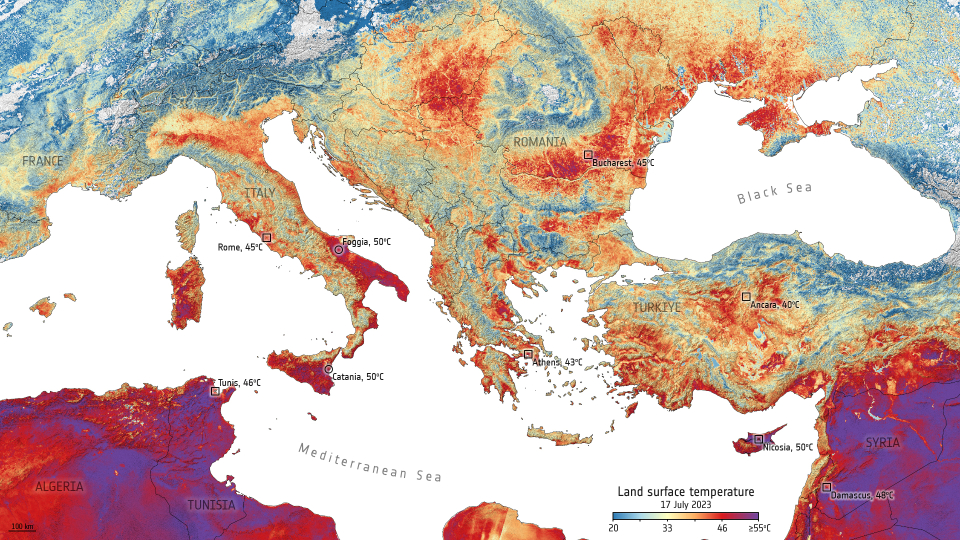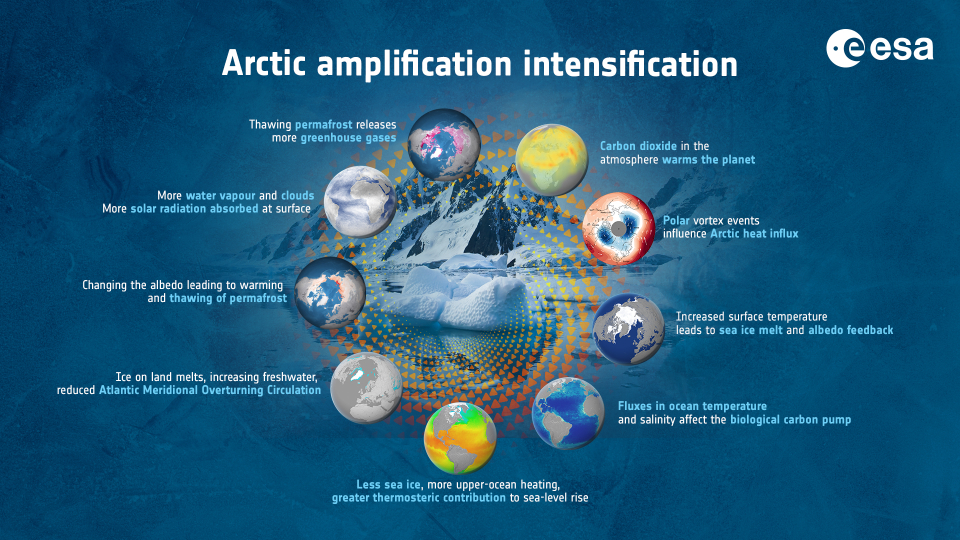Gepubliceerd op 19 juli 2023
To keep pace with the challenges we face, the European Space Agency (ESA) is embarking on a new Earth observation science strategy – and has reached out to the scientific community at this early stage in the process to help guide the Agency’s scientific agenda for the coming years.

Land surface temperature on 17 July 2023
More than ever, Earth observation-based science forms a critical part of our efforts to understand and address the many complex challenges facing our world.
From climate change to natural disasters, to food and water security, data from satellites orbiting above and the resulting scientific knowledge provide valuable insights into these global issues and help make informed decisions about how these challenges can be best addressed.
At the same time, observing Earth from space has become a dynamic and fast-developing sector. It is critical to build on the latest advances in technology, data analytics and modelling to develop a comprehensive and integrated approach to Earth observation, while ensuring that the underlying science questions remain relevant.
Paving the way for the new Earth Observation Science Strategy, ESA taken the first two steps; firstly launching a Science Strategy Foundation Study, which has resulted in a comprehensive set of Earth science questions, and an early open consultation with the scientific community.
ESA’s Malcolm Davidson said, “Our current strategy was issued in 2015 and identified key challenges that limit our understanding in specific areas such as oceans, ice, land and atmosphere. Our satellite missions, particularly our Earth Explorer research missions, have responded to these challenges and been extremely successful in delivering information to improve our understanding of our planet in these areas – and new missions in the pipeline are set to advance our knowledge even further.
“Nevertheless, Earth observation is evolving and has changed dramatically since 2015. We are seeing, for instance, how quickly our planet is being altered by the climate and the needs of a growing global population.
“Advances in Earth system science, in remote sensing, in-situ observations, and digital information technology are also opening the door to new and unprecedented opportunities for advancing science, which ESA needs to grasp.”
The new science strategy will respond these challenges by focusing more on our understanding the Earth as a system.

The Arctic is experiencing disproportionately higher temperature increases compared to the rest of the planet, triggering a series of cascading effects known as Arctic amplification.
ESA’s Mark Drinkwater added, “Like the human body, our Earth is made up of diverse parts that interact in complex ways. Better insight into how our planet works, how it will evolve in the future and how it responds to issues such as climate change is key to understanding these interactions through the use of observations from space.
“This is complicated science. In order for us to have a solid roadmap in place by mid-2024 we first launched a comprehensive international study as a way for scientists to help us identify key science questions. These questions express future science priorities and their role in addressing important gaps in our knowledge of the Earth system, as well as societal benefits linked to addressing these science drivers.”
A workshop was therefore held recently, giving the scientific community the opportunity to put their ideas and needs forward.
Simonetta Cheli, ESA’s Director of Earth Observation Programmes, said, “Our science strategy will be a bold and ambitious scientific vision for the future.
“It will outline the research objectives, priorities, and approaches for scientific activities within our Earth Observation Programmes. It will identify the key scientific questions to address associated challenges and opportunities, as well as embrace opportunities such as digital innovation, open science, commercial space, national programmes and policy directives.
“We recognise this is very complex and interconnected, and requires a multidisciplinary and collaborative approach, but we want our projects to continue to push the boundaries of our understanding of the Earth system.
“I’d like to thank everyone who has contributed to these important initial steps. This will help us to formulate a roadmap for implementing our programmes over the next several years to a decade.”
The next step will be for ESA to start preparing the Earth Observation Science Strategy, building on results from the workshop and the foundation study activity, in consultation with the Advisory Committee on Earth Observation.
A draft strategy document is anticipated to be ready in spring 2024 when, by popular demand, a second consultation is planned with the science community to review the document.
The goal is to finalise the strategy by mid-2024 and to proceed with its implementation.
Source:
European Space Agency. (2023, July 18). New strategy to keep pace with our changing world. Observing the Earth.